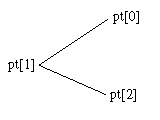L_AnnGetPoints
#include "l_bitmap.h"
L_LTANN_API L_INT L_AnnGetPoints(hObject, pPoints)
HANNOBJECT hObject; |
handle to the annotation object |
pANNPOINT pPoints; |
pointer to the array to be updated |
Fills the specified array of ANNPOINT structures with the vertices of the specified annotation object.
Parameter |
Description |
hObject |
Handle to the annotation object. |
pPoints |
Pointer to the array that this function will fill with the vertices of the specified annotation object. |
Returns
SUCCESS |
The function was successful. |
< 1 |
An error occurred. Refer to Return Codes. |
Comments
You can use the L_AnnGetPointCount function to determine the required size of the array before calling this function.
The ANNPOINT structure is like a Windows POINT structure, except that it uses double-precision floating point values.
Coordinates of an object's points are relative to its container object. The coordinates are interpreted using the container's scaling factors and offsets, which are described in Low-Level Coordinate System for Annotations.
L_AnnGetPoints works only with the following types of objects:
ANNOBJECT_AUDIO
ANNOBJECT_BUTTON
ANNOBJECT_CROSSPRODUCT
ANNOBJECT_CURVE
ANNOBJECT_CURVECLOSED
ANNOBJECT_ELLIPSE
ANNOBJECT_ENCRYPT
ANNOBJECT_FREEHAND
ANNOBJECT_FREEHANDHOTSPOT
ANNOBJECT_HILITE
ANNOBJECT_HOTSPOT
ANNOBJECT_LINE
ANNOBJECT_NOTE
ANNOBJECT_POINT
ANNOBJECT_POINTER
ANNOBJECT_POLYGON
ANNOBJECT_POLYLINE
ANNOBJECT_POLYRULER
ANNOBJECT_PROTRACTOR
ANNOBJECT_PUSHPIN
ANNOBJECT_RECT
ANNOBJECT_REDACT
ANNOBJECT_RTF
ANNOBJECT_RULER
ANNOBJECT_STAMP
ANNOBJECT_TEXT
ANNOBJECT_TEXTPOINTER
ANNOBJECT_VIDEO
For annotation objects that are defined by a rectangle, use the L_AnnGetRect function.
You can get the position of a Point object using the following:
ANNPOINT apt;
L_AnnGetPoints(hPoint, &apt);
where hPoint is the handle to the point object.
To retrieve the points of a cross-product object, do the following:
ANNPOINT apt[5];
L_AnnGetPoints(hPoint, apt);
hPoint is the handle to the cross-product object. apt[0] and apt[1] are the points for the primary ruler. apt[2] is the intersection point. apt[3] and apt[4] are the points for the secondary ruler.
To retrieve the points of a protractor object, do the following:
ANNPOINT apt [3];
L_AnnGetPoints(hPoint, apt);
hPoint is the handle to the cross-product object. apt[0] and apt[2] are the endpoints for the two rulers. apt[1] is the intersection point. This is shown below:

For an ANNOBJECT_TEXTPOINTER object, pPoints is updated with 5 points. The first four points are coordinates of a rectangle. The last two are the endpoints of the "pointer" segment.
Note: You can not create a line of two points which they are the same.
Required DLLs and Libraries
|
For a listing of the exact DLLs and Libraries needed, based on the toolkit version, refer to Files To Be Included With Your Application. |
Win32, x64.
Example
This example gets the points for an object, shrinks the object by 1/2 and then puts the points back onto the object.
L_INT AnnGetPointsExample(L_INT x,L_INT y,HANNOBJECT hContainer)/* Container annotation object */{L_INT nRet;HANNOBJECT hObject; /* Local variable for the annotation object */POINT PointToTest; /* The point in the window's client area to test */L_UINT TestResult; /* Result of the test */pANNPOINT pPoints; /* Pointer to the points in the object */HGLOBAL hPoints; /* Handle for memory management */L_UINT uCount; /* Number of points in the object */L_UINT i;ANNRECT rcDefine; /* Defining rectangle for the object */ANNRECT rcDefineName;L_DOUBLE cx; /* Center point */L_DOUBLE cy;L_UINT uObjectType = 0;ANNHITTESTINFO HitTestInfo;/* Did we hit an object? *//* Use incoming coordinates to specify the point to test */PointToTest.x = x;PointToTest.y = y;/* Get the object at the specified point */memset(&HitTestInfo, 0, sizeof(ANNHITTESTINFO));HitTestInfo.uStructSize = sizeof(ANNHITTESTINFO);nRet = L_AnnHitTest ( hContainer, &PointToTest, &TestResult, &hObject, &HitTestInfo, sizeof(ANNHITTESTINFO));if(nRet != SUCCESS)return nRet;// Verify the hittest object is not a containerL_AnnGetType(hObject, &uObjectType);if (uObjectType == ANNOBJECT_CONTAINER)return FAILURE;if ( TestResult == ANNHIT_BODY ){/* first, get the # of points in the object */L_AnnGetPointCount ( hObject, &uCount );/* Allocate and lock a storage for the points */hPoints = GlobalAlloc(GPTR, sizeof(ANNPOINT) * uCount);pPoints = (pANNPOINT)GlobalLock( hPoints );/* Now, get the points */L_AnnGetPoints ( hObject, pPoints );/* Get the defining rect, and find the center point */L_AnnGetRect ( hObject, &rcDefine, &rcDefineName);cx = (rcDefine.right + rcDefine.left) / 2;cy = (rcDefine.bottom + rcDefine.top) / 2;for (i=0; i<uCount; i++){pPoints[i].x += (cx - pPoints[i].x) / 2;pPoints[i].y += (cy - pPoints[i].y) / 2;}/* Put the new points back into the object */L_AnnSetPoints ( hObject, pPoints, uCount );GlobalUnlock (hPoints);GlobalFree (hPoints);}return SUCCESS;}
© 1991-2017 Apryse Sofware Corp. All Rights Reserved.
